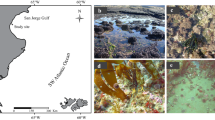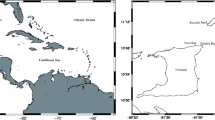Abstract.
Regular sea urchins of the families Cidaridae and Echinidae are widespread and sympatrically occurring epibenthic species in Antarctic waters. Food preference and water depth distribution of the five most abundant species (Ctenocidaris gigantea, C. spinosa, Notocidaris mortenseni, Sterechinus antarcticus, S. neumayeri) were analysed based on trawl and photograph samples. Both diet and water depth contribute to niche separation among these species. All sea urchins consume bryozoans and sediment, but echinids feed predominantly on diatoms in the fluff, when available. Cidarids do not consume diatoms, most likely owing to morphological constraints; their typical food consists of sponges and hydroids. C. spinosa and S. neumayeri prefer shallow water depths, whereas N. mortenseni and S. antarcticus prefer deeper regions. C. gigantea is the most variable species regarding food composition and living depth.
Similar content being viewed by others
Author information
Authors and Affiliations
Additional information
Electronic Publication
Rights and permissions
About this article
Cite this article
Jacob, .U., Terpstra, .S. & Brey, .T. High-Antarctic regular sea urchins – the role of depth and feeding in niche separation. Polar Biol 26, 99–104 (2003). https://doi.org/10.1007/s00300-002-0453-0
Received:
Accepted:
Issue Date:
DOI: https://doi.org/10.1007/s00300-002-0453-0




